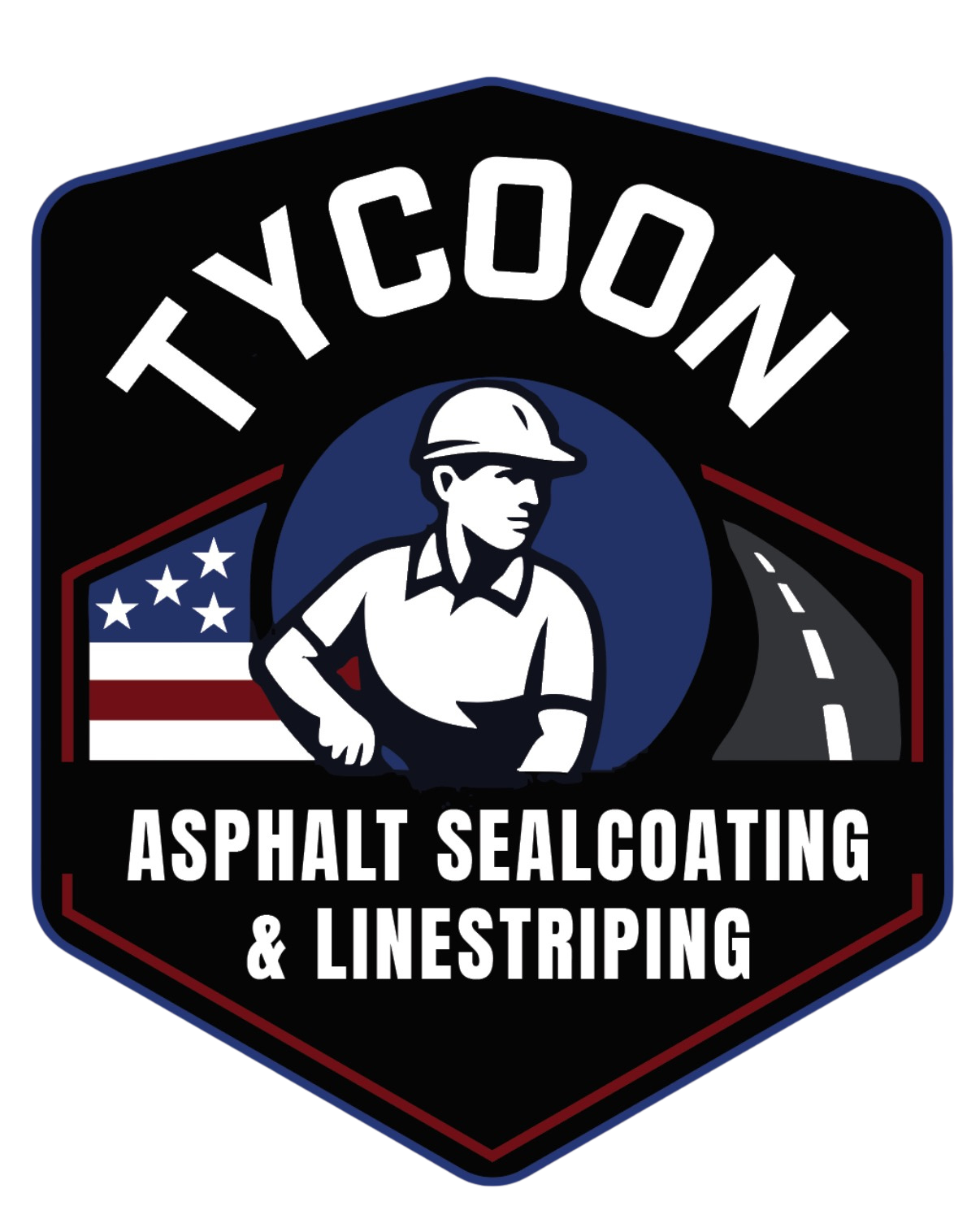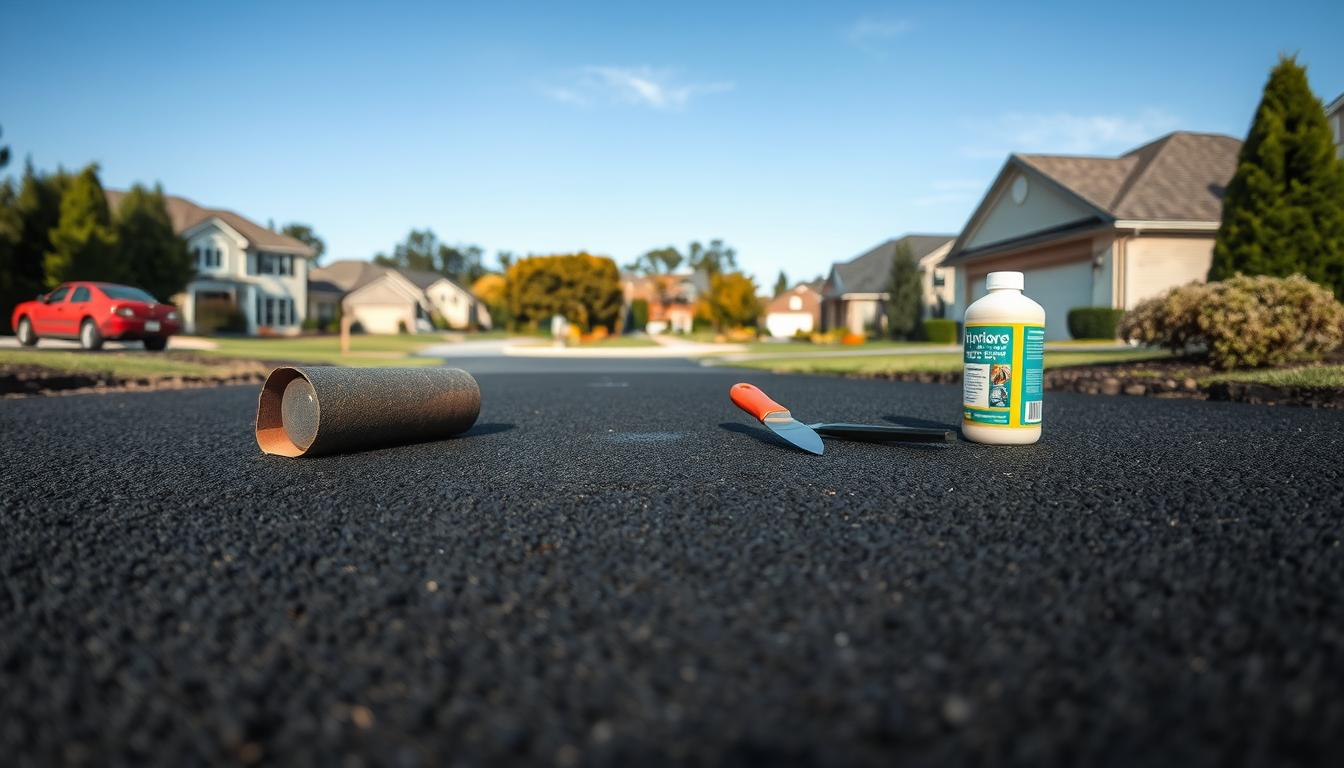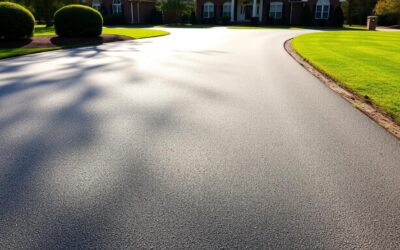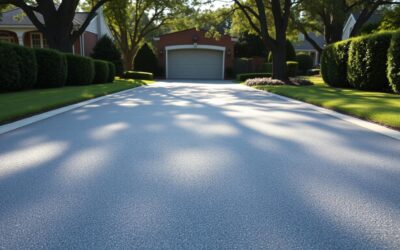We introduce simple fixes we can do safely and the limits where pro services make more sense. Timely attention to cracks and minor damage keeps our asphalt driveway usable and protects curb appeal.
Before we start, we assess the surface, clean with a wire brush and blower, and follow manufacturer instructions for long-lasting results. Local weather conditions affect product choice and timing, so we plan around heat and rain.
Charlotte Paving & Sealcoating has served our area for over 50 years with quality materials and craftsmanship. We can text or call (980) 505-4195 for a free estimate and 15% off paving and sealcoating this summer.
In this guide, we walk through assessing cracks, gathering tools, prepping, completing the task, and scheduling future upkeep. We also remind ourselves to wear gloves and eye protection, document before-and-after photos, and contact today if we spot structural issues that need repair services.
What we’ll cover to help you tackle diy asphalt repair charlotte with confidence
This section walks us through the practical steps to fix surface damage and avoid costly follow-ups. We start by showing how to assess cracks, measure width and depth, and spot patterns that signal bigger problems.
Next, we match materials to our needs: fillers like asphalt emulsion, rubberized asphalt, or cold-pour sealants. We explain safe techniques for cleaning, drying, filling, smoothing, and sealing so results last longer.
We set realistic time expectations, from quick small-crack fixes to longer cure windows before vehicle use. We list the materials and PPE to keep on hand and flag when services make more sense—such as major patches, overlays, or full asphalt paving.
Local experience shapes our plan: choose workdays that suit weather and allow proper drainage. We also cover preventive habits and sealcoating to protect surfaces from moisture and UV, reducing repeat cracks and extending lifespan.
Assessing asphalt cracks and surface damage before we start
We begin by measuring and mapping every visible crack and area of damage. Measure width and depth with a ruler or crack gauge so we can pick the right filler and method.
Next, we map crack patterns. Single, linear cracks are often manageable with simple fills. Spiderweb or alligator patterns usually point to base failure or structural issues that need a pro evaluation.
How to measure width, depth, and crack patterns
Use a tape or small ruler for width and a probe for depth. Record each reading and photograph the area for later comparison.
Small cracks vs structural issues: when DIY makes sense
Small cracks that are narrow and shallow fit a straightforward fix. Wide, deep, or interconnected cracking likely signals bigger problems and calls for professional services.
Parking lot and driveway red flags that require repair services
Look for spreading potholes, soft subgrade, edge failures, and areas where water pools or drains toward the pavement. These red flags affect the whole property and may need heavy equipment or a full overlay.
Tools, materials, and techniques for a quality repair
We pick the right tools and sealants so each fix lasts through summer heat and wet spells. Start with the cover choices and match them to the crack size and our goals for speed or durability.
Choosing the right filler
For hairline to small gaps, asphalt emulsion or cold-pour sealants work well. Rubberized asphalt is the better option for wider, deeper openings that need flexibility and strength.
Climate and product fit
Local weather conditions—hot, humid summers and sudden rain—mean we pick products rated for heat and moisture. Staging buckets in the shade keeps viscosity steady on hot days and makes application cleaner.
Toolkit and technique
We keep a wire brush, high-powered blower, caulking gun, putty knife, and basic PPE on hand. Clean and dry the crack, apply with steady beads, smooth edges, and follow cure windows for quality results.
If voids are deep, use a backer or primer before filling. Call expert asphalt teams for large or structural jobs beyond our scope so the asphalt paving work holds up long term.
Surface preparation that sets the stage for durability
Good surface prep is the step that decides whether a fix lasts for years or shows up again next season.
We start by clearing loose debris with a wire brush, then follow with a high‑pressure blower so filler bonds to clean sidewalls and bottoms. This basic technique boosts adhesion and helps prevent quick failure.
After cleaning, we treat any vegetation with a targeted weed killer to stop roots from reopening cracks. Then we confirm the area is completely dry before we apply filler. Trapped moisture weakens bonds and can lead to water damage.
We also evaluate drainage and adjust so water shed away from the work area. Proper drainage reduces the chance of future damage and extends maintenance windows.
Masking edges keeps lines tidy when needed. We use light, even passes to avoid overfilling and keep the surface level with surrounding asphalt.
Finally, we note nearby damage for quick touch‑ups and double‑check tools so our techniques stay consistent from start to finish.
Step-by-step DIY asphalt crack repair
We outline a simple routine that covers cleaning, filling, smoothing, and curing so repairs hold up over time.
Filling cracks properly and smoothing the surface
First, cut and clean each crack with a wire brush, then blow out dust and debris so the filler bonds to solid sides. Make sure the surface is dry before you begin.
Load a caulking gun and apply a steady bead from the bottom up, filling the void fully. Slightly overfill, then smooth with a putty knife until the surface is flush and neat.
Feather the edges to blend with the surrounding pavement. This reduces telegraphing when the area is sealed later and helps prevent future spreading.
Sealing the repaired area and optional full driveway sealcoat
After the filler cures per product directions, consider a local seal over the patch for added protection. For a uniform look and longer life, a full driveway sealcoat is an option.
Use a product rated for our climate and follow label guidance for application technique and coverage. Document materials and methods so we can repeat the best approach next season.
Cure times, foot traffic, and vehicle use
Cure time depends on temperature and shade. Follow manufacturer guidance and delay foot and vehicle traffic until the area reaches full hardness.
Inspect for minor sinkage after the initial cure and top off small cracks if needed. Watch high‑traffic paths first; prompt fixes there help prevent more damage.
Charlotte specifics: drainage, water, and timing our work
Controlling how water moves across our lot cuts the risk of recurring cracks and potholes. Good drainage keeps pools from forming and limits water damage that shortens pavement life.
Improving drainage to prevent water damage and future cracks
We check slopes, gutters, and curb lines so runoff moves away from repaired zones. Low spots and clogged downspouts invite moisture under the surface and speed deterioration.
For heavy rainfall, professionals can add trench drains, French drains, or regrade areas to direct flow. These fixes protect a parking lot or driveway and help prevent future failures.
Scheduling around rain and summer heat for best results
We plan work during dry stretches and avoid start times that risk rain during cure windows. Rain can wash uncured material and ruin a day’s work.
In summer, we stage jobs earlier to dodge peak heat and use temporary shading or cooling to keep materials manageable. High humidity lengthens cure time, so we allow extra time before reopening the area to traffic.
When in doubt, we document drainage adjustments and revisit patches after the first big storm. If drainage issues are complex, we follow up with pros to ensure long-term protection and reduce the need for frequent repair.
maintain your aging asphalt driveway
Asphalt maintenance that extends lifespan and curb appeal
We set a simple, seasonal routine that keeps surfaces durable and our property looking sharp.
Sealcoating every 2–3 years shields pavement from UV, water, and oil. This step helps extend lifespan and preserve curb appeal. A newly paved surface can last 15–20 years with steady upkeep and prompt crack repair.
Sealcoating frequency and seasonal checkups
We schedule quick inspections each spring and fall. These short visits catch small issues before they grow. Refresh markings after sealcoat for a crisp, safe look.
Preventive steps to protect against UV, oil, and heavy loads
We clean spills fast, sweep regularly, and avoid point loads that cause depressions. Track wheel paths and loading zones so we can treat high‑stress spots early.
Small annual budgets for maintenance let us prevent future, costly projects. With regular attention, our parking lot and asphalt driveway stay functional and attractive.
DIY asphalt repair Charlotte
We balance hands‑on cost savings with realistic limits to pick the best path for the job.
For small cracks, simple fillers and sealants are a cost‑effective solution we can apply on our schedule. This option gives flexibility and helps us learn techniques for future work.
Pros and cons of doing the job ourselves
Pros: lower material costs, flexible timing, and quick fixes for narrow gaps.
Cons: limited tools, longer timelines for larger patches, and risk of improper material choice that shortens life.
When to call professional asphalt repair services in Charlotte
Contact repair services charlotte pros for deep, interconnected cracking, subgrade failures, or visible structural issues. Safety concerns and heavy traffic areas also warrant pro evaluation.
What to expect: timelines, materials, and workmanship quality
Pros bring specialized equipment, years experience, and quality controls that speed work and often include warranties. They offer broader material options and proven mixes for larger repairs.
Get two or three quotes and clarify scope so the chosen solution matches our needs and budget. That step helps us compare timelines, expected traffic return, and warranty terms for peace of mind.
Local expertise matters: repair services Charlotte homeowners and businesses trust
Trusted local contractors combine on-site experience with equipment to deliver consistent results. We value crews that know our neighborhoods, soils, and seasonal timing.
What professional teams bring: experience, equipment, and warranties
Local firms offer decades of years experience, trained crews, and heavy equipment that speed a job. They handle mix selection, compaction, and finish quality so the surface looks right and lasts.
Many teams include warranties and post-service cleanup. That coverage gives us confidence and protects our investment over time.
From small fixes to overlays for parking lots and driveways
Services scale from quick patches on an asphalt driveway to full overlays for a busy parking lot. Timelines vary: small jobs may take a day, larger projects run several days and can be phased to limit downtime.
We recommend a short consultation to compare options, review drainage and grading, and get a clear quote. Contact today for a free estimate and seasonal savings from a local family-owned team with 50+ years in town.
Ready to restore your asphalt surface? Let’s plan your next steps
It’s time to turn observations into action and schedule the right scope of work for lasting results.
.
We summarize our plan: assess cracks, gather materials, prep thoroughly, perform the repair, and seal for a durable finish. We decide if a quick consultation or local services offer better value for our property and timeline.
Options range from spot fixes and an asphalt driveway patch to overlays for a busy parking lot. We map access, set cure‑time windows, and pick materials that suit climate and traffic.
Sealcoating every 2–3 years and prompt crack filling push lifespan toward 15–20 years. For a free estimate and 15% off this summer, call Charlotte Paving & Sealcoating at (980) 505-4195. That consultation gives a clear scope, price, and schedule so we proceed with confidence.




0 Comments